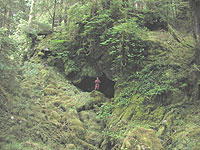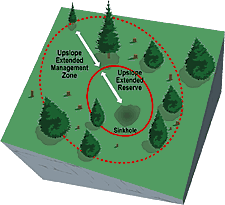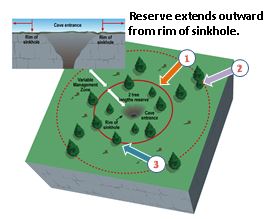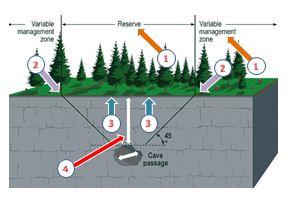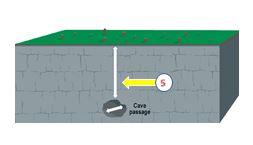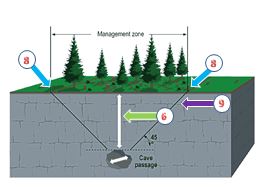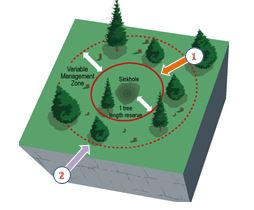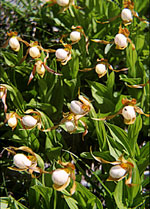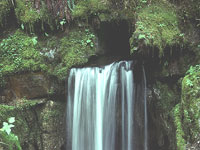Managing significant karst features (lesson 3)
On this page
- Learning objectives
- Introduction
- Managing windthrow
- Significant cave entrances
- Above significant caves
- Significant surface karst features
- Significant karst spring
- Unique or unusual flora/fauna habitat
Learning objectives
This lesson introduces the management objectives and recommended best management practices for significant karst features. By working through this lesson you will:
- objectives for various significant karst featuresUnderstand the specific management
- Be familiar with the best management practices recommended for specific significant karst features.
Introduction
In Lesson 2 you read how significant karst features are usually identified during karst field assessments. Lesson 3 provides more detailed information on significant karst features and how the higher values associated with these types of features can be protected.
The significance of karst features is conducted during a karst field assessment.
Criteria for determining the significance of surface karst features:
- Dimensional characteristics
- Level of connectivity between the surface and subsurface
- Hydrological characteristics
- Geological, biological, scientific, archeological, historical, cultural and educational values
- Recreational and commercial values
- Rarity and abundance
- Visual quality.
Criteria for determining the significance of caves:
- Well-developed decorations
- Significant hydrological, archaeological, paleontological or cultural values
- Bat hibernacula or rare cave-dwelling organisms
- Scientifically important climatological or geomorphological sediments
- Significant recreational opportunities
- Unique intrinsic values (for example, large dimensions, unusual configuration, rare/uncommon location).
Since determining the significance of caves requires subsurface inspection and mapping, it should only be done by personnel with specialized knowledge, training and experience.
Below: A karst cave - Click for larger image
Managing windthrow
The suggested reserve sizes for significant karst features and values in this section are default recommendations. However, local site conditions should be carefully considered when planning reserve shapes and sizes.
The planning and design of all karst reserves should be based on a thorough windthrow assessment. If the default karst reserve recommendations cannot be maintained due to severe windthrow potential, professional judgment should be used to develop site-specific management practices that achieve as many of the management objectives for the reserve as possible.
Below: Extending reserves and management zones on steep slopes - click for larger image
In addition, the default recommendations for reserve size are based on relatively flat terrain. Where features occur on slopes, there may be a need to alter the shape and size of the reserve and/or management zone. On steep slopes, this could involve extending the reserve and/or management zone on the upslope side of features (for example, sinkholes) to account for the increased risk of slumping and soil erosion. Reserves and management zone widths on slopes should be measured using slope distance.
For more information on assessing windthrow risk, see:
Significant cave entrances
The following section summarizes the management objectives and recommended best management practices for significant cave entrances. As these are only brief summaries, you should also check out more detailed information in the Karst Management Handbook for British Columbia.
The following is a summary of the management objectives designed to protect significant cave entrances. Reserves should:
- Maintain the microclimate around significant cave entrances
- Maintain stable habitat conditions for any flora or fauna inhabiting the cave entrance or cave
- Prevent logging debris from entering significant cave entrances
- Provide a measure of aesthetics/recreational experience for cave entrances with high recreational values.
Recommended best management practices
- Leave a minimum two-tree-length reserve extending outward from the mouth of the cave entrance. In the case of a significant entrance contained within a sinkhole, the reserve should extend from the rim or edge of the sinkhole, as defined by the upper break of the slope enclosing the sinkhole.
- Leave an adjacent management zone of an appropriate size to protect the reserve from windthrow. See Managing Windthrow.
- Leave understorey vegetation along reserve boundaries, and green trees in the opening to help maintain interior microclimatic conditions and inhibit the encroachment of edge species into the reserve.
Below: The two-tree-length reserve is based on the average height of the dominant and co-dominant trees at 100 years - Click for larger image.
Reserve extends outward from rim of sinkhole
Reserve extends outward from mouth of cave
For reserves around entrances of caves known to contain bat hibernacula or species at risk, follow the recommendations in Managing Identified Wildlife: Procedures and Measures (PDF).
Practices recommended for cave entrances that don’t meet the criteria of significant cave entrances
- Use a 20-metre management zone around the entrance
- Fall and yard away from the cave entrance as much as possible
- Remove any slash and debris that falls in or around the cave entrance, provided removal does not cause further disturbance
- Retain windfirm non-merchantable trees, advanced regeneration, wildlife trees, and other windfirm vegetation within the management zone.
Above significant caves
The following section summarizes the management objectives and recommended best management practices for above significant caves.
Management objectives
The following is a summary of the management objectives designed to protect the area above significant caves. Reserves should:
- Maintain stable conditions for karst processes above and within significant caves (for example, temperature, humidity, infiltration rates, drip water chemistry)
- Prevent the migration of surface fines/sediment into significant caves through fissures or cavities in the overlying epikarst
- Protect delicate cave features, cave fauna, etc. from being damaged by vibrations associated with road construction and timber harvesting
Recommended best management practices
1. Establish reserves and management zones of an appropriate size to protect the reserve from windthrow above significant caves situated less than three times the greatest dimension (height or width) of the cave passage below the surface of the ground.
2. Base the size and shape of the reserve on the principle that the cave is primarily affected by diffuse percolation within a 45-degree angle on either side of the outside wall of the cave passage.
3. The size and shape of the reserve can be projected to the surface using cave maps. Significant caves situated less than 10 metres below the surface should receive a reserve in all cases, regardless of whether the cave meets the 3x depth criteria or not.
4. Significant caves situated less than 10 metres below the surface should receive a reserve in all cases, regardless of whether the cave meets the 3x depth criteria or not.
Below: Reserve zones - Click to enlarge
Reserves are recommended if significant caves are situated less than three times the greatest dimension (height or width) of the cave passage or less than 10 metres below the surface of the ground.
5. Where the cave ceiling lies more than three times the greatest dimension (height or width) of the cave passage and at least 10 metres below the surface, harvesting can occur safely in most instances.
Below: Reserve zones - Click to enlarge
No reserve is recommended for significant caves where the ceiling lies more than three times the greatest dimension (height or width) of the cave passage and at least 10 metres below the surface (including soil cover).
6. Significant caves that are deeper than three times the greatest dimension (height or width) of the cave passage and at least 10 metres below the surface, but are known to contain exceptional features or values, should receive special consideration.
7. Consider using specialized harvesting practices such as partial cutting, maximum/full suspension yarding, and leaving coarse woody debris and non-merchantable vegetation, to maintain soil humidity above caves with exceptional features or values.
8. The size of the management area for specialized harvesting practices can be projected to the surface using the 45-degree principle.
9. If 0.5 metres or more of soil is likely to be left after harvesting, the use of partial cutting and maximum/full suspension yarding may not be required. However, retaining more coarse woody debris and non-merchantable vegetation should be considered to help maintain soil humidity above the cave.
Below: Reserve zones - Click to enlarge
A management zone is recommended for significant caves with exceptional features or values, even if situated more than three times the greatest dimension (height or width) of the cave passage and at least 10 metres below the surface.
Significant surface karst features
The following section summarizes the management objectives and recommended best management practices for significant surface karst features.
Management objectives
The following is a summary of the management objectives designed to protect significant surface karst features. Reserves should:
- Protect significant surface karst features from physical damage
- Maintain any site-specific microclimatic conditions and/or habitat/ biodiversity characteristics associated with significant surface karst features
- Prevent soil erosion and sediment transfer into subsurface openings or caves
- Preserve a measure of the aesthetic/recreational experience for surface karst features with high recreational values
Recommended best management practices
- Leave a minimum one-tree-length reserve extending outward from the edge of the feature. For sinkholes, the edge of the feature should be considered the rim of the sinkhole, as defined by the upper break of the slope enclosing the sinkhole
- Leave an adjacent management zone of an appropriate size to protect the reserve from windthrow. See Managing Windthrow
- In cases where surface karst features have high recreational values, the reserve size/shape may need to be adjusted to manage visual quality
- Sinkholes large enough to create their own microclimate should be managed similarly to a significant cave entrance, with a reserve of two tree lengths to maintain interior microclimatic conditions
Below: Karst surface features - Click to enlarge
Reserves and management zones around significant surface karst features.
Significant karst spring
The following section summarizes the management objectives and recommended best management practices for significant karst springs.
Management objectives
The following is a summary of the management objectives designed to protect significant karst springs. Reserves should maintain:
- Water quality and quantity
- Wildlife habitat
- Visual quality, in cases where recreational values are identified
Recommended best management practices
- Leave a minimum 20-metre reserve extending outward from the discharge point
- Leave an adjacent management zone of an appropriate size to protect the reserve from windthrow
- If the spring discharges into a stream channel or disperses into a wetland, consult the default standards for riparian management as specified in the regulations supporting the Forest and Range Practices Act
- Consider the level of activities conducted in the recharge areas of karst springs when managing for water quality and quantity
- Where unique or unusual species are encountered around karst springs, consult the Conservation Data Centre for assistance in determining appropriate management actions
Below: Karst springs - Click to enlarge
Karst springs often create favourable environmental conditions and habitats for rare flora and fauna.
Unique or unusual flora/fauna habitat
The following section summarizes the management objectives and recommended best management practices for unique or unusual flora/fauna habitats.
Management objectives
The management objective for unique or unusual flora/fauna habitats is to maintain critical aspects of the habitat.
Recommended best management practice
Where unique or unusual species of flora or fauna are encountered, consult the Conservation Data Centre for assistance in determining appropriate protective actions.
Below: Unique flora in a karst environment - Click to enlarge
Self check questions
Answer either True or False to check your understanding:
- The significance of a karst feature is determined during a planning-level inventory.
- If the significance of a karst feature is unknown, it should be treated as significant until a determination can be made
- To maintain the microclimate around significant cave entrances, a minimum one-tree-length reserve is recommended
- Cave entrances not classified as significant can be managed with a 20-metre management zone
- A major management objective above significant caves is to prevent the migration of sediment into the caves through epikarst openings
- A reserve should be established above a significant cave situated less than two times the greatest dimension (height or width) of the cave passage or less than 10 metres below the surface
- The size and shape of reserves above significant caves can be projected to the surface using cave maps
- One of the management objectives for significant surface karst features is to maintain any site-specific habitat
- A one-tree-length reserve should be established around significant surface karst features
- Establish a minimum 50-metre reserve around significant karst springs.
- For information on identifying and protecting unique or unusual karst flora or fauna, consult the Conservation Data Centre
Self Check Answers
- False
- True
- False
- True
- True
- False
- True
- True
- True
- False
- True

